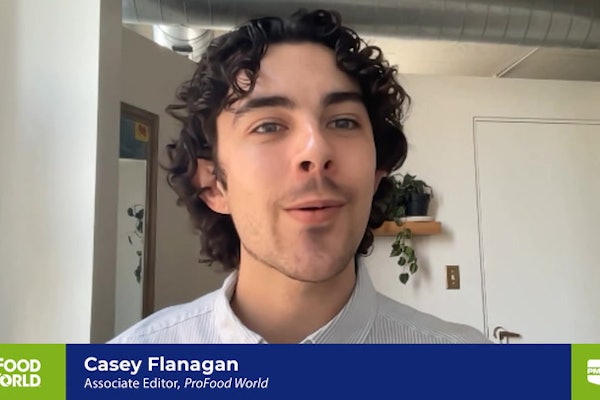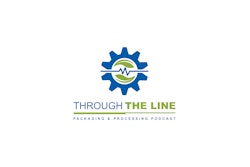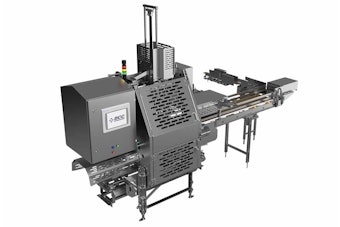In just three years, the packaging science program at the University of Florida, Gainesville, has experienced incredible growth. Since the official launch of packaging as a new major during the fall 2001 semester, undergraduate enrollment in the UF program has doubled each year. Currently, 27 students are enrolled for the spring 2004 semester. Degrees awarded at the completion of the program is the Bachelor of Science in packaging science.
Like the program itself, the packaging building was built from scratch. A new facility was dedicated in 2001 with all the amenities a modern building offers including spacious, well-lighted laboratories. The faculty has quickly been filling the lab space with timely research projects that draw the interest of—and funding from—packagers and vendors.
For example, radio-frequency identification is a topic as hot as Florida in summer—Packaging World’s visit, fortunately, was this spring—so it should have come as no surprise that the packaging laboratories include production-scale RFID portals (see sidebar opposite).
“We’re pretty busy with projects,” says assistant professor Bruce Welt. Welt is a chemical engineer with a master’s degree in food science from Rutgers, the State University of New Jersey, and a Ph.D. in food process engineering from UF. He has a real-world background including working in research and development at Nestle.
“Our goal is to remain diverse by applying knowledge across industry lines,” says Welt. “In Florida, there are significant opportunities for packaging in medical, pharmaceutical, agricultural, food, waste, and gerontology. We want to develop a reputation of service and expertise in all of these areas, rather than focusing on any one industry or segment.”
Still, it seems natural that the latest projects in UF’s packaging science program have a food- and seafood-based flavor as these examples show:
Fresh Seafood Packaging A recent Food and Drug Administration ruling has essentially halted the practice of packing fresh fish in hermetically sealed packaging, which can cause botulism. FDA guidelines require such packaging to use either films with a minimum oxygen transmission rate of 10ꯠ cc O2/m2 per day or use of a time-temperature indicator (TTI) device to ensure products are not exposed to thermal abuse.
Research in the UF labs has focused on performance specification and measurement of commercially available TTIs including those of Avery Dennison, Cox Technologies, and Lifelines, Inc., as well as basic research related to improving the OTR guideline specified by FDA. Funded through Florida Sea Grant, National Fisheries Institute, and the UF’s Institute for Food and Agricultural Sciences (IFAS), the project was completed earlier this year.
Produce Packing Productivity A tomato packer, Custom Pak, Inc., division of Six L’s Packaging Company, Inc., Immokalee, FL, funded development of a system to track individual packer productivity. The project has resulted in a technique called Gator Packer™ that combines industrial-grade scanners with wireless technology. Bar codes affixed to sides of reusable plastic containers identify container contents and also individual packer.
Flow from many workers onto a common conveyor can then be tracked by packer so that his or her output can be monitored. “The goal is to identify and reward exceptional packers,” Welt says. He says the next steps include bar codes preprinted on containers. There are also plans this summer to enhance the Gator Packer with RFID capability.
Fresh-Cut Produce/Modified Atmosphere Packaging Research This project seeks to improve the quality and shelf-life of fresh-cut produce such as melon. Current packaging allows fresh-cut melon pieces to sit in purged juice for an extended period, which promotes bacterial growth and subsequent loss in quality and shelf life. The work evaluates the benefits of combining low-dose irradiation with MAP for such products. Funding is from IFAS.
During our tour, I viewed other projects throughout the facility that, while outside mainstream packaging, were decidedly intriguing. One included a sealed chamber that simulates the Mars environment. Another was a machine-vision-equipped robot that would discern and pick ripe oranges by color. The bioengineering lab has a project that converts waste to energy. “It’s to use and recycle everything, such as for long-term space missions,” Welt explains. He also thinks it will be possible to identify biotoxins in packaged foods using sensors that would alert consumers via color-changing biochemistry.
More news
Other news is that the Packaging Science staff has added Jean-Pierre Emond, Ph.D. A food engineer with a master’s degree in food science from Laval University, Canada, and a Ph.D. in food packaging from UF, “JP,” as he is called, has expertise in distribution and transportation. He is currently principal advisor for perishable packaging for IATA, the International Air Transport Association. After 12 years as professor in Food Engineering at Laval University, Emond also serves now as co-director of the newly formed Research Center for Food Distribution and Retailing. Its board includes representatives from industry leaders such as Wal-Mart and Royal Ahold, a Dutch retailer. The center’s mission is to provide the food industry and the scientific community with a unique environment that will assure food quality and safety throughout the whole distribution chain. The initial efforts of the center include what it bills as the “most advanced RFID laboratory for food applications” (see sidebar).
Amidst all this activity, UF’s packaging program also received a much-welcome shot in the coffers. In February, it received a $100ꯠ endowment upon the disbanding of the Packaging Education Forum, a grant topped only by that awarded to San Jose State University. “The PEF has been a good friend to us,” says Welt. “In light of the demise of PEF, the endowment was bittersweet.”
It’s the only bittersweet spot on the University of Florida packaging map; the rest of the program is a major sweet spot that’s juiced for packaging R&D.
See sidebar to this article: UF's RFID portals proliferate
For more about UF's program, see: packworld.com/go/w0128


















